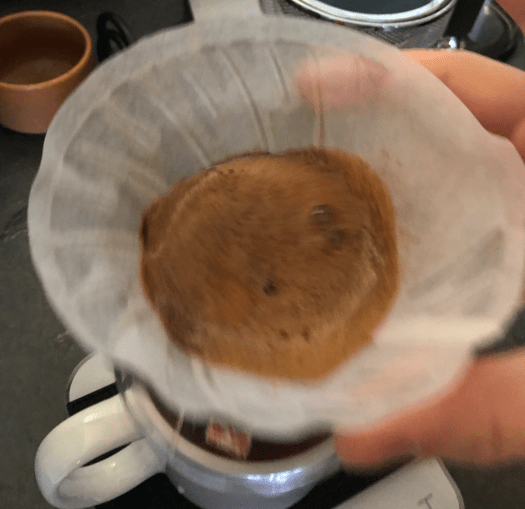Today I’m excited to release a joint blog post with Scott Rao, the one who helped me so much understand the basics of brewing, and also helped me to improve my cups of coffee significantly. I was never really proud to serve my friends a cup of V60 coffee that I made, and this is finally changing. After some discussions on my very unstable brew times, Scott made me realize that I needed to be a bit more careful with my execution of the spin. This led to a discussion about the physics of why that was. Scott asked me to try to explain this simply in a few paragraphs for a joint blog post – this is what came out of this idea. This blog post is also available on his own website, scottrao.com.
A preamble from Scott:
The history of The Spin is murky…although it’s often called the “Rao Spin,” I did not invent the spin. It’s likely that James Hoffmann was the first person to spin the slurry. Almost everyone to whom I’ve shown The Spin has immediately adopted it. It’s easy to execute well and it works, pretty much every time.
Jonathan Gagné, an astrophysicist based in Montreal, came to my roasting masterclass this past November. I’ve been fortunate to befriend Jonathan, as I’ve always wanted to have an astrophysicist on speed dial to call when I have a question about how things work :). I’ve been helping Jonathan with his coffee making and he’s been providing some great coffee-analysis resources, some of which I hope appear on this blog.
I asked Jonathan to explain why he believes The Spin works and we decided to publish his answer as a guest post here.
A Summary
In this post we will discuss the physics behind why spinning the V60 during a brew is a useful method to obtain a more uniform extraction. While spinning is helpful, it’s important not to overdo it – it can cause fine coffee grounds to migrate to the bottom of the slurry and clog the filter, slowing the drawdown and imitating a brew made with a lower-quality grinder.
So, why spin the slurry ?
Spinning the slurry during a V60 brew is useful to minimize the channeling of water that can lead to an uneven extraction. The reason why this is true can be understood with the help of physics.
A rotating slurry will experience a centrifugal force*, which means that every drop of water and every particle of coffee will suffer a force that pushes them outwards. In physics, the strength of centrifugal force is more important for heavier objects, and because of this, water will tend to migrate outward more than coffee because water is heavier.
When you brew coffee, the main cause for channeling is that dry coffee repels water more than wet coffee does. The physics behind this effect are not fully understood: they are related to the fact that molecules of water bond with each other, and dry coffee doesn’t bond with them in the same way. At first pour, water might begin travelling through a tiny hollow on the surface of the dry coffee, and then it will prefer to keep traveling through that same tunnel, because the rest of the coffee bed is still dry and repels water. In practice, a coffee bed will often develop several channels if you don’t take steps to avoid it.
When you rotate a channeled coffee bed, the water flowing down the narrow tunnels is forced out of them by the centrifugal force, and the water will wet some of the dry coffee. This horizontal re-mixing of the slurry will cause channeling to decrease overall.
There is, however, a drawback if you spin too much. As we mentioned earlier, heavier things are more affected by the centrifugal force. The largest coffee particles will thus experience a stronger pull toward the walls of the V60. In a slurry where coffee is mixed with water, this effect will be slightly reduced by water friction. Think of trying to run in the sea – the friction water exerts on you will slow down your movement, especially if you present it with a large surface, for example by wearing saggy pants. The friction is however not strong enough to completely stop the migration of particles based on their size, and the larger coffee particles will be sent outwards.**
This whole situation presents the smallest particles with an opportunity: the larger ones having moved out of the way, fines will sink down to the bottom of the V60, where they will be free to do their worst at clogging the paper filter. This will significantly slow down the flow of your brew.
As an illustration of this, I recently brewed a few V60s with a prewet-plus-two-pours method, performing a spin right after the prewet, and right after each of the two pours. At first I did not pay too much attention to how long or how strong I was spinning, and I experienced large inconsistencies in my brew time (up to ~20 seconds), which led to inconsistencies in average extraction yields by about 0.7%. I was controlling everything else, including the height from which I poured, the flow rate, timing, grind size, slurry temperature, etc.
I then tried timing my spins, and found that using seven-second spins resulted in a 5:18 drawdown time, while two-second spins resulted in a much shorter 4:28 drawdown time! This is a nice demonstration that fines can migrate and clog your filter if you spin too much. Adjusting the grind size appropriately to maximize extraction yield and avoid astringency, I found that the two-second spins resulted in a brighter and more enjoyable cup.
In summary, you want to spin just enough to break the up channels, but not so much that fines clog the bottom of the filter.

* I can already hear the interwebs shouting “CENTRIPETAL NOT CENTRIFUGAL”. Both concepts are valid and useful tools: when you stand outside of a rotating system and want to describe forces acting on that system that keep it together, the concept of a centripetal force (directed toward the center) is appropriate. It describes the external force that allows the system to keep going in this rotating motion without splattering everywhere around. In our case, this force is provided by the walls of the V60, preventing the slurry from flying around and messing up your counter. If, however, you take the point of view of the things rotating (the water and coffee), then the concept of a centrifugal force becomes very useful. You can then describe the system as if it was not rotating, by just adding a slight modification: you add an artificial “pseudo force”, also called an “inertial force” that points toward the outside, in our case the “centrifugal force”. It is often called an “inertial force” because it arises from the fact that your frame of reference (the V60 in this case) is rotating (in technical terms, it is “not inertial”). A “pseudo force” is by no means a false thing or an invalid concept, as long as you understand where it arises from and use it carefully — in fact, one can even see gravity as a pseudo force (Einstein realized that), yet it is very useful in everyday situations to view gravity as just a normal force.
** The mass of a coffee particle is proportional to its volume, which is itself proportional to the cube of its size. The water friction that the particle experiences is proportional to its surface, or to the square of its size. As a consequence, a particle three times larger will be nine times more massive and will feel nine times more centrifugal force, but only six times more water friction. If you combine the two effects, it will therefore be pushed outwards 9 – 6 = 3 times more.


Hello Jo, great crazy stuff. I like it.
Looking at my cup of water with air bubbles floating inside. They won’t spin in a circle when I do “The Spin(TM)”. All I succeed in doing is raising high waves in my cup. So, although seducing, invoking the centripetal force has me wondering… I thing you’re correct though that particle sorting is operating and doing what you want to achieve. It would interstiing to check whether you achieve the same result by shaking instead of making a circular movement? Anyway, I dunno nothing about this business. But keep the ideas moving!
LikeLike
CENTRIPETAL ??? Hahaha, more seriously, I guess shaking could work, but shaking with a human hand would probably not lead to a flat bed of coffee, which is what we want to achieve to avoid channeling. Maybe a perfectly uniform and “strong” shaking with a machine could also achieve this, with less particle sorting. Should I get a lab shaker, or maybe a sound system subwoofer, and try this out ? 😛
LikeLike
Hi Jonathan,
Thanks for your sharing.
Here is some questions.
In Matt Perger’s v60 video (https://vimeo.com/46612013), there is a “Rao spin achieved via pour”. But it’s totally different with your version of rao spin, Perger’s version seems not much centrifugal force on coffee particles. Do you think this kind of whirl can still reduce some channeling?
LikeLike
Yes this seems like a gentler version of the spin. Inducing any rotation motion will create some centrifugal force that will create similar effects as those achieved with the manual spin. I do think this whirl could potentially reduce some channeling, assuming the rotation motion diffuses into the coffee bed (I’m not sure it does) – this is where you want to break the channels. I think manual spinning is a more foolproof way to do it, you just still need to be gentle, and I recommend practicing it (see my 2nd blog post for that).
LikeLike
What about spinning in the case of using Kalita Wave or other Flat bed brewer?
Will it clot too much?
LikeLike
I would spin the same when using a flat-bottom dripper. However, some drippers like Kalita Wave are prone to clogging, depending on holes, filter material and filter placement. If you also have a grinder or coffee that generates lots of fines and experience clogging, I would recomment swirling only once after the bloom and doing it more carefully. However, consider adding a tea strainer mesh below the filter first if you are brewing with a Kalita or Stagg [X], it may fix all of your clogging issues.
LikeLike